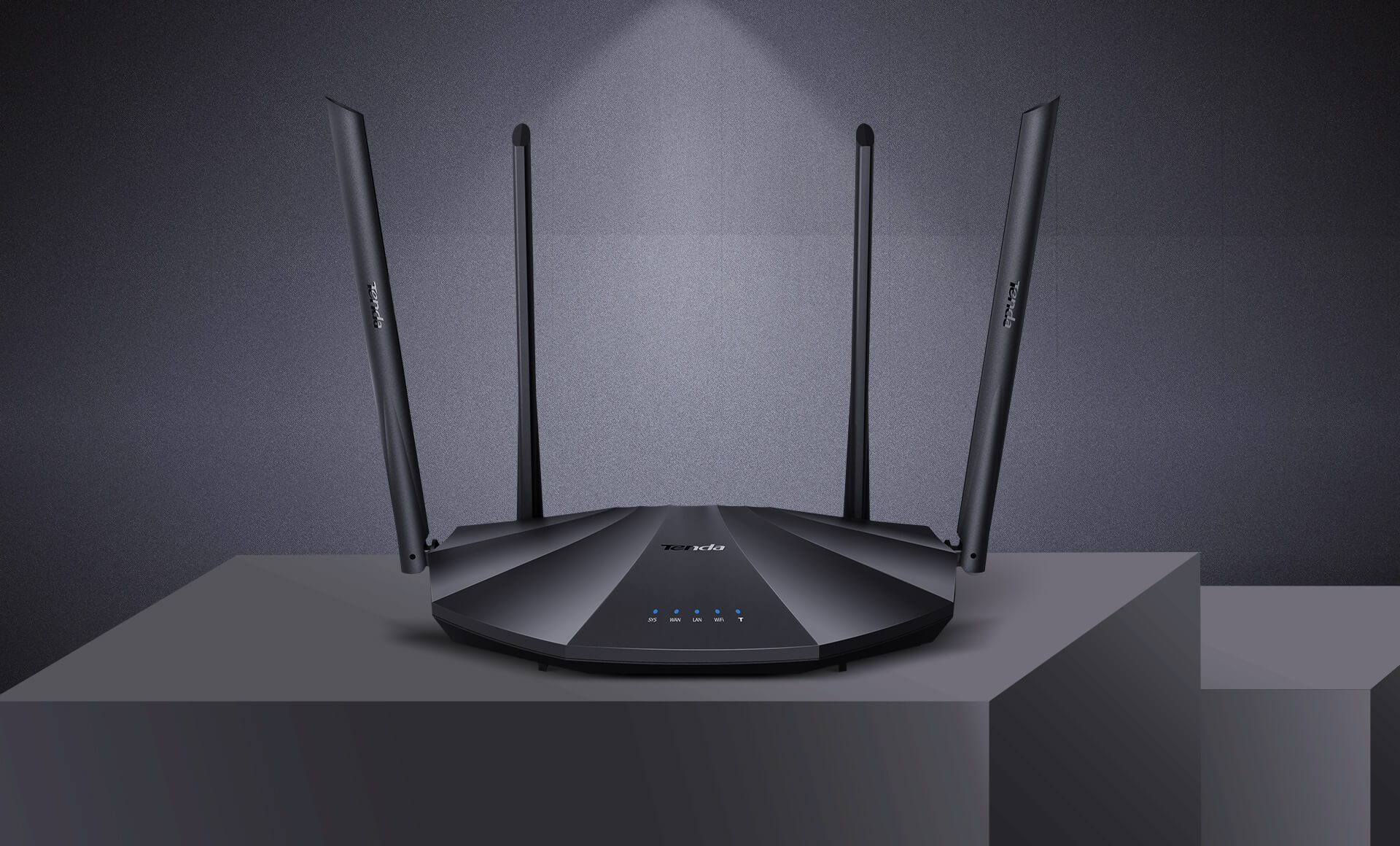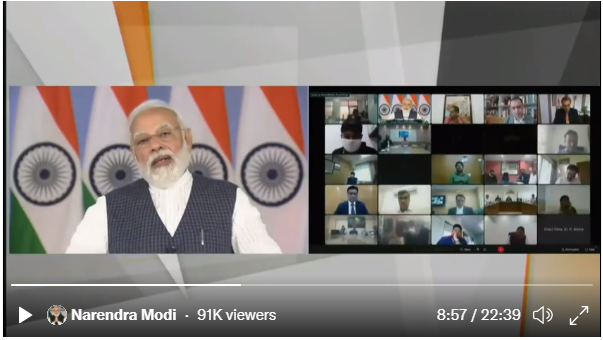Broadband
Tenda launches all new AC19 High speed Gigabit Wireless Router in India

NEW DELHI: Tenda, technology is a leading supplier of networking devices and equipment, has launched its all-new AC19 Smart Dual-Band Gigabit Wi-Fi Router in India.
The introduction of the new router is an extension to its existing portfolio; will be strengthening existing smart Wi-Fi router line-up of Tenda while providing secure, reliable, and blazing fast Wi-Fi speeds.
Tenda AC19 is a dual-band gigabit wireless router specially designed for households that require high-speed internet access. It supports 802.11ac wave2 Technology and provides Wi-Fi speeds up to 2033 Mbps (2.4 GHz: 300Mbps, 5GHz: 1733Mbps) to achieve the best performance. The new router is equipped with the latest 4X4 MU-MIMO technology of 5GHz band that yields wider Wi-Fi coverage and a faster Wi-Fi speed as compared to regular routers with older 3X3 MU-MIMO technology.
The newly launched Tenda AC19 is stocked with 28nm 1GHz CPU equipped with 500MHz co-processor, dual-core design that helps in faster processing speed and in optimized operation. Also, the router has an in-built signal amplifier used both on 2.4GHz and 5GHz bands of AC19 to enhance the penetration capability and expand the Wi-Fi coverage. It is also the first router from Tenda to use 6*6 dBi external antennas and four data streams of 5Ghz band to provide a better 5GHz Wi-Fi signal.
Tenda AC19, like Tenda’s other AC series wireless router, is equipped with MU-MIMO and Beamforming+ Technology features that help in an unrivalled coverage and stable performance. MU-MIMO Technology ensures a stable wireless connection and increases the quality of connected clients and data processing while Beamforming Technology boosts range for 802.11ac wave2 Wi-Fi devices.
Tenda AC19 comes equipped with full gigabit ports that provide Fiber Internet upto 1000 Mbps. AC19 also supports IPv6, it can reduce the data transmission time and minimizes the lag, provide a better gaming experience. Like other Tenda Wi-Fi routers, AC19 is also equipped with a “Smart Tenda Wi-Fi App” that helps in real-time management of your network.
One of the unique features that make Tenda AC19 stand apart from its competitors is it’s “Smart Traffic Prioritisation” feature which combines both 2.4GHz and 5GHz under one Wi-Fi name, automatically analyze the surrounding internet environment optimizing the Wi-Fi channel/bandwidth while avoiding interference to provide faster signal frequency.
Speaking on the launch, John Dong, Director, Tenda India commented “We at Tenda trust in creating and conveying best expectations of developments and innovation through our determined endeavours. With the dispatch of AC19 Dual-band Gigabit Wireless Router, we are carrying present day innovative headways to the Indian market. Tenda AC19 is intended to meet all fundamentals WiFi standards for small offices and high speed online gamers.”
Key Features and Benefits:
· 4×4 MU-MIMO for 5GHz band
· Built-in signal amplifier for main chip
· Supports fiber internet up to 1000Mbps
· USB port for media sharing
· Supports IPv6 protocol
4×4 MU-MIMO for 5GHz band
Powered by 4X4 MU-MIMO technology of 5GHz band, it provides wider Wi-Fi coverage and faster Wi-Fi speed than regular routers with 3X3 MU-MIMO technology.
Built-in signal amplifier for main chip
Built-in signal amplifier used both on 2.4GHz and 5GHz bands of AC19 to enhance the penetration capability and expand the Wi-Fi coverage.
Supports fiber internet up to 1000Mbps
Equipped with full Gigabit ports, it supports up to 1000Mbps bandwidth access.
USB port for media sharing
AC19 provides USB sharing, supporting memory sharing, printer remote access and other features. You can set up a local FTP server by connecting AC19 with a hard drive. HD movies and photos can be uploaded and shared with your family anytime, anywhere.
Supports IPv6 protocol
AC19 supports IPv6, it can reduce the data transmission time and minimize the lag, provide a better gaming experience.
Pricing and Availability:
Tenda AC19 Dual-band Gigabit Wireless Router is available through Amazon.in and IT reseller shop at an introductory price of MRP 12500/- across India.
Broadband
Broadband will not only provide facilities but will also create a big pool of skilled youth in Indian villages

NEW DELHI: Rural digital connectivity is no longer mere aspiration but has become a necessity, said Prime Minister Shri Narendra Modi while addressing a post-budget webinar on the recently announced Union Budget 2022.
The theme of the webinar ‘Leaving No Citizen Behind’ was aimed at bringing industry leaders, policymakers and government officials together to deliberate upon the positive impact of the budget and identify sector specific actionable strategies to collectively work towards furthering the common goal of upliftment of everyone with saturation of each household and village, leaving no one behind.
Speaking at the webinar, Prime Minister said that Broadband will not only provide facilities in the villages but will also create a big pool of skilled youth in the village economy. He further emphasized that Broadband, will enable expanding the service sector to rural areas and help in boosting the economy. He stressed the need for a saturation approach to provision of basic infrastructure, especially in aspirational districts. He also emphasized the need for spreading awareness about the use of such connectivity and healthy competition between villages in achieving targets.
The Union Budget 2022-23 has provided an impetus to the telecom sector through a budget announcement which proposes to allocate 5% of annual collections under the USOF to promote R&D and commercialisation of technologies and solutions in order to enable affordable broadband and mobile services proliferation in rural and remote areas. In addition it has also been proposed to cover all villages on optical fiber network by 2025.
In order to carry forward and sustain the momentum of budget and to create a sense of ownership in budget implementation by all relevant stakeholders, a series of webinars were organised through various Ministries and Departments. One such post-budget webinar was organised by Department of Rural Development on the theme “Leaving No Citizen Behind”. One of the break-away session was on “Road & Info way to all rural habitations”. This session was moderated by K. Rajaraman, Secretary(T), Department of Telecommunications, and was co-moderated by Dr. Ashish Kumar Goel, Addl. Secretary, Ministry of Rural Development.
In this session various eminent speakers such as P.K. Purwar, CMD, BSNL, Gopal Vittal, CEO, Bharti Airtel, Manoj Kumar Singh, ACS, Rural Development, Uttar Pradesh, Prof. A. Veeraraghavan, Department of Civil Engineering, IIT Madras, and V. Sriniwas, CEO, Vishwa Samudra Engineering, Hyderabad talked about various aspects of broadband connectivity and development in rural roads sector.
It was felt that digital saturation is the foundation for the achieving all facets of development including financial, social or economic development especially in rural and remote areas.
For achieving 100% saturation, it was indicated that convergence of all stakeholders is required to provide cost and technology efficient services which is also part of GatiShakti program of the Government of India. BharatNet shall be leveraged for the same and utilised for early saturation of all rural and remote areas including ensuring uptime and SLA as per norms for better demand.
A need was felt that Outcome Focus shall be the main objective in all government programs and schemes. Innovation conferences may be one of the activities to ensure new development of technologies apart from focussed development of rural specific content.
Based on discussion and inputs of stakeholders, RoW issues were identified as key challenges and efforts need to be made to mobilise the State government departments including creation of National Portal for early resolution through Single window clearance.
Industry experts also indicated the need for focus on supply side and demand side constraints including power requirement of telecom, focus on green telecom and reduction in tax and fees structure and regulatory fees for the services etc. The implementation strategy of the Department for rollout of broadband in rural areas will include this valuable feedback and inputs from various stakeholders.
Broadband
Tremendous potential for proliferation of Wi-Fi hotspots in India: TRAI

NEW DELHI: Tremendous opportunity exists for the rapid proliferation of public Wi-Fi hotspots in India, and the PM WANI initiative can result in a massive scale-up of the internet in rural areas, which will be transformative, Trai Chairman said on Friday.
India needs all kinds of technology to serve its digital ambitions, and the technology-neutral stance will serve as a prime catalyst for the required growth, P D Vaghela, Chairman of Telecom Regulatory Authority of India (Trai), said.
“There is a tremendous opportunity in India for the proliferation of public Wi-Fi hotspots. PM WANI (PM Wi-Fi Access Network Interface) can result in rapid scale-up of the internet in rural areas, which will be transformative given the low level of penetration (there) compared to urban areas,” he said while speaking at a virtual event organised by industry body Broadband India Forum (BIF).
India’s appetite for data appears to be insatiable, with the country now having over 750 million broadband connections.
“However, the potential for growth is still very high. I think, probably over 500 million more to be connected, especially in rural areas,” he pointed out.
Terming the internet as one of the most powerful socio-economic engines of growth, Vaghela said this is true not only for India but for the rest of the world.
“Wi-Fi 6 and 5G expand opportunities for digitisation across all industries…and enables organisations to be just everywhere, while increasing productivity and offering the best user experience,” he said.
The PM WANI initiative has been a historic step forward, he said, referring to the ambitious programme that aims to fuel broadband internet proliferation in the country through a mesh of public Wi-Fi networks and access points by local Kirana and neighbourhood shops.
“PM WANI system is a best low-cost alternative, which offers a way forward to connect low revenue consumers…,” he noted.
The BIF digital dialogues event also witnessed the release of an industry white paper titled Role and importance of next-generation Wi-Fi technologies in the acceleration of digital transformation’.
Some gaps need to be ironed out for the PM WANI scheme to pick up, the white paper said, flagging the need to create wider awareness about the scheme, its technical design, the utility of Public Wi-Fi services and associated benefits.
“A regulation prescribing ceiling rate with guaranteed QoS (quality of service) may be considered by Trai to ensure that ISPs/TSPs (internet and telecom service providers) do not exercise discriminatory practices in allocating bandwidth and pricing for PDOAs/PDOs,” BIF said summing up key suggestions contained in the white paper.
The government should facilitate easy bank loans or funding from USOF (Universal Service Obligation Fund) for small entrepreneurs to invest in the PDO/PDOA business, it said while calling for suitable modifications in the WANI framework to facilitate roaming.
“Spectrum in both 6 GHz and V band has been delicensed in several countries, to increase capacity and accelerate economic growth. Need to explore releasing these bands in India at the earliest to unlock their economic value through use in Wi-Fi services,” it added.
The government had earlier approved the setting up of public Wi-Fi networks and access points by local Kirana and neighbourhood shops through public data offices that will not involve any licence, fee or registration.
The public Wi-Fi Access Network initiative is aimed at bringing a massive Wi-Fi revolution in the country. The public Wi-Fi networks, under WANI, have an architecture involving multiple players — Public Data Office (PDO), Public Data Office Aggregators (PDOAs) and app providers.
Source: Press Trust of India
Broadband
Nokia modernizes Subisu’s optical network for high-speed broadband across Nepal

NEW DELHI: Nokia today announced that it had been selected by Subisu, a leading service provider in Nepal, to modernize the 1500 kilometers long backbone network spread across East and West Nepal.
In a first-of-its-kind initiative in Nepal, Nokia has deployed its 400G single fiber solution to provide ultra-high-speed broadband to Subisu’s retail and enterprise subscribers.
Nokia’s solution allows Subisu to address the growing bandwidth requirement and break into new market segments. Subisu’s customers will be able to use high-capacity applications and experience an overall improvement in the quality of services.
Nokia 1830 Photonic Service Switch (PSS) platform offering Photonic Service Engine (PSE) enabled 400G single fiber, bidirectional Dense Wavelength Division Multiplexing (DWDM) solution is now deployed across the country. This is the first operation of such a solution anywhere.
Nokia’s 400G single fiber solution significantly improves fiber capacity and helps Subisu enhance network resilience and reach while optimizing capex and reducing opex. The solution allows Subisu to easily scale the network to provide multi-terabits of capacity over a single fiber.
Binaya Saud, CEO, Subisu, said: “We have been working with Nokia for a long time now, and their industry-leading products and solutions are helping us provide best-in-class broadband services to our subscribers. Nokia was the sole vendor for this important project, and its solutions are enabling us to grow our subscriber base and provide a superior experience to our existing customers even as we future-proof our investments.”
Vinish Bawa, Head of Emerging Markets, India, Nokia, said: “Our field-proven 1830 PSS solution is enabling service providers, like Subisu, to meet the growing capacity demand even as they enhance customer experience. We are pleased with the successful and timely completion of this crucial project to modernize Subisu’s optical network, and we look forward to working with them in the future.”





